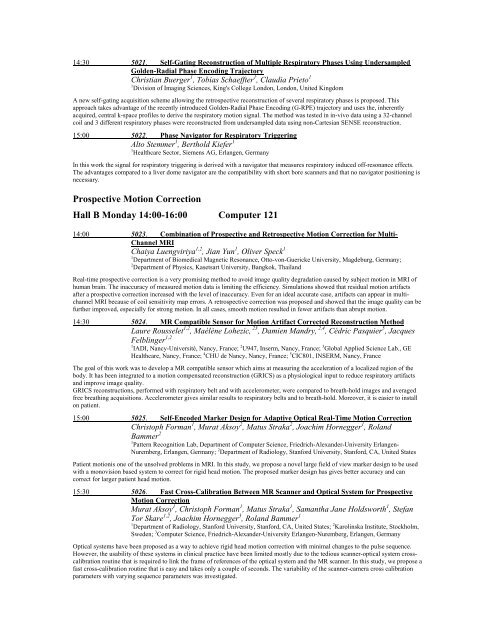ELECTRONIC POSTER - ismrm
ELECTRONIC POSTER - ismrm
ELECTRONIC POSTER - ismrm
Create successful ePaper yourself
Turn your PDF publications into a flip-book with our unique Google optimized e-Paper software.
14:30 5021. Self-Gating Reconstruction of Multiple Respiratory Phases Using Undersampled<br />
Golden-Radial Phase Encoding Trajectory<br />
Christian Buerger 1 , Tobias Schaeffter 1 , Claudia Prieto 1<br />
1 Division of Imaging Sciences, King's College London, London, United Kingdom<br />
A new self-gating acquisition scheme allowing the retrospective reconstruction of several respiratory phases is proposed. This<br />
approach takes advantage of the recently introduced Golden-Radial Phase Encoding (G-RPE) trajectory and uses the, inherently<br />
acquired, central k-space profiles to derive the respiratory motion signal. The method was tested in in-vivo data using a 32-channel<br />
coil and 3 different respiratory phases were reconstructed from undersampled data using non-Cartesian SENSE reconstruction.<br />
15:00 5022. Phase Navigator for Respiratory Triggering<br />
Alto Stemmer 1 , Berthold Kiefer 1<br />
1 Healthcare Sector, Siemens AG, Erlangen, Germany<br />
In this work the signal for respiratory triggering is derived with a navigator that measures respiratory induced off-resonance effects.<br />
The advantages compared to a liver dome navigator are the compatibility with short bore scanners and that no navigator positioning is<br />
necessary.<br />
Prospective Motion Correction<br />
Hall B Monday 14:00-16:00 Computer 121<br />
14:00 5023. Combination of Prospective and Retrospective Motion Correction for Multi-<br />
Channel MRI<br />
Chaiya Luengviriya 1,2 , Jian Yun 1 , Oliver Speck 1<br />
1 Department of Biomedical Magnetic Resonance, Otto-von-Guericke University, Magdeburg, Germany;<br />
2 Department of Physics, Kasetsart University, Bangkok, Thailand<br />
Real-time prospective correction is a very promising method to avoid image quality degradation caused by subject motion in MRI of<br />
human brain. The inaccuracy of measured motion data is limiting the efficiency. Simulations showed that residual motion artifacts<br />
after a prospective correction increased with the level of inaccuracy. Even for an ideal accurate case, artifacts can appear in multichannel<br />
MRI because of coil sensitivity map errors. A retrospective correction was proposed and showed that the image quality can be<br />
further improved, especially for strong motion. In all cases, smooth motion resulted in fewer artifacts than abrupt motion.<br />
14:30 5024. MR Compatible Sensor for Motion Artifact Corrected Reconstruction Method<br />
Laure Rousselet 1,2 , Maélène Lohezic, 23 , Damien Mandry, 2,4 , Cédric Pasquier 5 , Jacques<br />
Felblinger 1,2<br />
1 IADI, Nancy-Université, Nancy, France; 2 U947, Inserm, Nancy, France; 3 Global Applied Science Lab., GE<br />
Healthcare, Nancy, France; 4 CHU de Nancy, Nancy, France; 5 CIC801, INSERM, Nancy, France<br />
The goal of this work was to develop a MR compatible sensor which aims at measuring the acceleration of a localized region of the<br />
body. It has been integrated to a motion compensated reconstruction (GRICS) as a physiological input to reduce respiratory artifacts<br />
and improve image quality.<br />
GRICS reconstructions, performed with respiratory belt and with accelerometer, were compared to breath-hold images and averaged<br />
free breathing acquisitions. Accelerometer gives similar results to respiratory belts and to breath-hold. Moreover, it is easier to install<br />
on patient.<br />
15:00 5025. Self-Encoded Marker Design for Adaptive Optical Real-Time Motion Correction<br />
Christoph Forman 1 , Murat Aksoy 2 , Matus Straka 2 , Joachim Hornegger 1 , Roland<br />
Bammer 2<br />
1 Pattern Recognition Lab, Department of Computer Science, Friedrich-Alexander-University Erlangen-<br />
Nuremberg, Erlangen, Germany; 2 Department of Radiology, Stanford University, Stanford, CA, United States<br />
Patient motionis one of the unsolved problems in MRI. In this study, we propose a novel large field of view marker design to be used<br />
with a monovision based system to correct for rigid head motion. The proposed marker design has gives better accuracy and can<br />
correct for larger patient head motion.<br />
15:30 5026. Fast Cross-Calibration Between MR Scanner and Optical System for Prospective<br />
Motion Correction<br />
Murat Aksoy 1 , Christoph Forman 1 , Matus Straka 1 , Samantha Jane Holdsworth 1 , Stefan<br />
Tor Skare 1,2 , Joachim Hornegger 3 , Roland Bammer 1<br />
1 Department of Radiology, Stanford University, Stanford, CA, United States; 2 Karolinska Institute, Stockholm,<br />
Sweden; 3 Computer Science, Friedrich-Alexander-University Erlangen-Nuremberg, Erlangen, Germany<br />
Optical systems have been proposed as a way to achieve rigid head motion correction with minimal changes to the pulse sequence.<br />
However, the usability of these systems in clinical practice have been limited mostly due to the tedious scanner-optical system crosscalibration<br />
routine that is required to link the frame of references of the optical system and the MR scanner. In this study, we propose a<br />
fast cross-calibration routine that is easy and takes only a couple of seconds. The variability of the scanner-camera cross calibration<br />
parameters with varying sequence parameters was investigated.
















